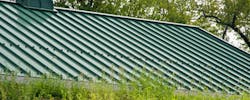Counter Corrosion with Specialized Coatings
Coatings play a significant role in protecting substrates from corrosion. There is, of course, an aesthetic aspect to coatings—consumers like to have color options—but the bottom line is that coatings are there to protect substrates.
Valspar has three coatings in particular that work to counter corrosion: Fluropon®, a high-end coating used for residential and commercial projects; WeatherXL™, a silicon-modified polyester used in mid-range residential and commercial projects; and WeatherXL Crinkle Finish, which provides buildings with a unique textured appearance.
Since steel, commonly used on roofs, is composed of iron, it will rust over time in the presence of oxygen and moisture. Applying a protective coating on a steel substrate can prevent this from happening and deter the process for a longer period of time. It is critical to have a well-prepared clean surface, as well as the proper conversion coating or pre-treatment applied—or the results will be poor adhesion, explains Jay Register, an R&D Chemist from Valspar’s Garland, Texas, lab.
“At some point, you may end up seeing the paint bubbling or blistering and just peeling right off,” Register says. “It is critical that the coaters prepare the substrate well and use the appropriate pre-treatments, which serve to promote adhesion of the primer to the substrate. Adhesion of the primer is critical to corrosion protection.”
Valspar’s primers and topcoats are designed for use in multiple environments and locations. One coastal primer was developed for locations that are within 1,500 feet of seaside environments. “Coastal environments provide a much harsher environment due to the presence of salt and moisture, so the substrate is attacked more aggressively on the steel or aluminum,” Register says. “The coastal primer provides the needed protection for these harsh environments.”
In addition to providing color retention and longevity, topcoats combined with a corrosion resistant primer offer long-term weathering and corrosion resistance. The pigments used in Fluropon and WeatherXL Crinkle are high-performance mixed-metal type pigments that provide strong weathering over many years and contribute to the integrity of the coating.
The testing that Valspar does on its coatings fall into two categories: accelerated testing and exterior long-term testing. Accelerated test methods seek to simulate outdoor environments in terms of heat, moisture, and UV radiation. “Some of these tests are looking at the possible durability of a coating in terms of its color retention and longevity in the field,” Register says. “Other accelerated test cabinets such as salt spray and prohesion test the ability of the coating to resist corrosion.”
But better results come from exterior testing, Register says. The company uses two major sites for exterior testing.
There are more than 100,000 panels located at the Valspar Fort Myers, Fla., test site. Panels are placed at a 45-degree angle facing south. This is the angle/direction at which the most intense concentration of UV radiation occurs on the surface of the panel. This type of testing helps researchers understand the impact of UV radiation in a very high moisture environment and how the coatings are going to perform. “We have panels out there of our Fluropon products that were placed in 1965, and they still have good gloss and color retention,” Register says.
For corrosion testing, panels are placed at the Daytona, Fla., test site facing east. Panels are set up at a 90-degree angle within 500 feet of the coastal line. “We are getting a very intense, real-world environment setting where we can test the performance of the coatings in terms of corrosion resistance.”
Fluropon Extreme, a 70 percent PVDF product, came into being because certain types of wear damage that occur in the field, when customers or end users were forming the metal and/or transporting the metal, seemed to be more prevalent than others.
“We were able to formulate the Fluropon in such a way that gave increased resistance to wear damage and transit abrasion,” Register says. “We looked specifically at those places where the damage was occurring and where the customers had concerns. We were able to identify a test that was able to duplicate that type of damage. Because if you can’t duplicate the damage, you can’t repair or provide a solution to prevent that damage.
All three of these finishes can be used with solar-reflective pigments to keep buildings cool and provide superior performance in terms of color retention, longevity, durability, and corrosion resistance.

